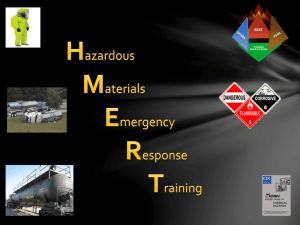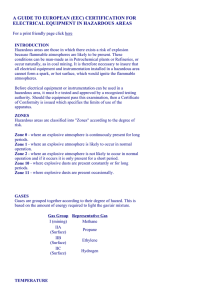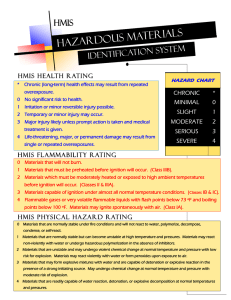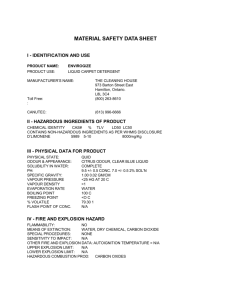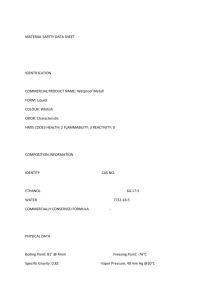ATEX Directives & Hazardous Area Classification (EN 60079-10-1)
advertisement
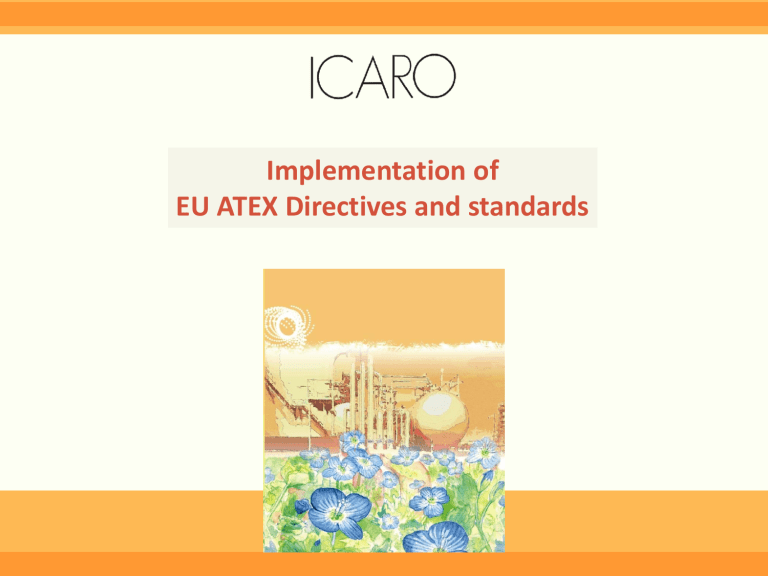
Implementation of EU ATEX Directives and standards October 2015 Page 1 Introduction In the general framework of implementation of EU Directives and standards, Turkey has amended European Harmonized Standard EN 60079-10-1 and 99/92/EC (ATEX directive for workplace). And 60079-14-1 ? Well, maybe next time . . . October 2015 Page 2 General Framework Hazardous Area Classification (HAC) is the process of classification of areas where flammable gas or vapor or mist hazards may arise and may then be used as a basis to . . . . . support the proper selection and installation of equipment for use in an hazardous area. October 2015 Page 3 Area classification In most practical situations where flammable materials are used, it is difficult to ensure that an explosive gas atmosphere will never occur. It may also be difficult to ensure that equipment will never give rise to a source of ignition. Therefore, reliance is placed on using equipment which has a low likelihood of creating a source of ignition. Conversely, where the likelihood of an explosive gas atmosphere occurring is reduced, equipment constructed with less rigorous requirements may be used. October 2015 Page 4 Area classification Probability of explosive atmosphere ZONE 2 October 2015 Probability of an ingnition Category 3 Category 2 ZONE 1 ZONE 0 Probability of an ingnition Probability of explosive atmosphere Category 1 Page 5 Is this a risk assessment ? Not exactly: consequences are not specifically estimated Probability of Occurrence Area classification 9 I N T O L E R - 8 A B L E 7 A 6 R E G L 5 A 4 3 I O N B R A 2 P R 1 1 2 3 4 5 6 7 8 9 Severity This part is missing October 2015 Page 6 Area classification The classification also takes into account the ignition characteristics of the gas or vapour such as ignition energy (gas group) and ignition temperature (temperature class). Selection of suitable apparatus and equipment affects both electrical systems and non electrical systems. EN 13463-1 «Non-electrical equipment for potentially explosive atmospheres. Basic method and requirements » October 2015 Page 7 Area classification The likelihood of the presence of an explosive gas atmosphere depends mainly on the grade of release and the ventilation. This is identified as a zone. Zones are recognized as: ZONE 0 ZONE 1 ZONE 2 ZONE NE Small enough not to cause significant consequences This is a risk assessment! More details: HSE RR630 - 2008 October 2015 Page 8 Area classification The extent of the zone depends on the estimated or calculated distance over which an explosive atmosphere exists before it disperses to a concentration in air below its lower explosive limit with an appropriate safety factor. 21% oxygen 100 kPa Ambient temperature When assessing the area of spread of gas or vapour before dilution to below its lower explosive limit, expert advice should be sought. October 2015 Page 9 Hazardous Area Classification according to EN 60079-10-1 EN 60079-10, whose first mandatory implementation was dated in 1996/09/01, represented a major change in the methodology applied when performing HAC. The whole perspective was revised. Previous codes (IP 15, API 500 etc.) offered a pre-determined collection of standard situations already assessed by experts (usually in terms of standard reference figures), leaving the designer only the possibility to select the one that would fit best to the actual contingency. Both ZONE type and relevant extent were already provided by the code. Example of compressor classification from API 500 Turbine Driven Compressor or pump in an Adequately Ventilated Nonenclosed Area October 2015 Page 10 Hazardous Area Classification according to EN 60079-10-1 When preparing EN 60079-10 (whose latest revision is 6007910-1) the relevant European committee (IEC-CENELEC) agreed on leaving to the designer the flexibility to perform his own specific assessment of the actual situation that he is facing (plant, installation, equipment etc.) leading to the results of a fully customized area classification. This can be achieved by performing specific calculation / modelling in order to represent the actual phenomena governing the formation and extension of explosive atmospheres. The following typical parameters shall be assessed in detail in a quantitative manner. October 2015 Page 11 Hazardous Area Classification according to EN 60079-10-1 List of main parameters affecting HAC when using EN 60079-10-1 Parameter Examples Wind speed, exchange rate, size and position of building opening Pressure Maximum operating pressure Maximum (typically for liquids) or minimum (for gases) Temperature operating temperature Physical properties Vapor pressure, lower flammable limit (LFL), density of the substances Mechanical Typology of connections, nature of gasket used for characteristics of flanges, nominal size of vents piping and relevant the equipment valves orifices Ventilation Once the parameters have been identified, suitable formula will allow the calculation of the released amount of vapor (passing through liquid evaporation if applicable) and finally the extent of the hazardous area. October 2015 Page 12 Hazardous Area Classification according to EN 60079-10-1 Sonic flow P>500 Pa October 2015 Page 13 Hazardous Area Classification according to EN 60079-10-1 The use of sophisticated software can be justified only if can allow a significant reduction of otherwise very large classified area (large releases). Graphical output of PHAST Software October 2015 Page 14 Hazardous Area Classification according to EN 60079-10-1 The potential and appealing reward will be a more refined HAC that, finally free from the conservativism of predetermined standard examples (which need to cover a full range of situations), will typically result into a lower extent of classified area and thus lower costs (in terms of both investment and maintenance). Furthermore the knowledge acquired about the mechanism and parameters affecting the hazardous area classification, will allow the designer to evaluate possible changes in the initial design and then assess the relevant cost vs benefit. October 2015 Page 15 Hazardous Area Classification according to EN 60079-10-1 EN 60079-10-1 Age of CODES Age of designer October 2015 Page 16 Comparing EN 60079-10-1 and API 500 Hazardous area classification of a gas compressor HAC according to EN 60079-10-1 depends on several additional properties of the system as: Typology (nature) of the gas Typology of the seal Actual pressure and temperature inside the compressor Combination of such properties would easily lead to an endless number of contingencies; for sake of simplicity let’s just consider two substances (acetylene and methane) and three level of pressure (5 barg, 10 barg and 50 barg). Temperature is considered fixed at 50°C and the type of seal, labyrinth type. The results are summarized in the table below. Substance Acetylene Methane Pressure (barg) Hazardous area extent to API 500 (m) 5 10 50 5 10 50 3 Hazardous area extent EN 60079-10-1 (m) 1,8 2,4 5,3 1,1 1,6 3,3 It shall be noted that, under specific conditions (high pressure), the extent can also increase compared to the one provided by previous deterministic standards. October 2015 Page 17 Comparing EN 60079-10-1 and API 500 Flexibility comes at a cost. The freedom that the designer will have for selecting the techniques (formula) for performing the detailed calculation required to estimate the ZONEs typologies and especially their extent will also represent a responsibility. Applying the formula also means going through all the necessary assumptions and being able to justify them by mean of adequate technical references. The result is that designer in charge for HAC has progressively shifted from an electrical specialist (electrical engineer) to a technician adequately familiar with the process parameters, substances handled, machine and piping characteristics. It is not so unlikely that the process engineer is directly involved in HAC or is even in charge for it. October 2015 Page 18 Comparing benefits and costs of EN60079-10-1 and API 500 API 500 EN 60079-10-1 Benefits October 2015 Disadvantages Flexibility Higher complexity of the methodology Fully reflecting and thus stimulating a thus requiring higher skillness and better design increased cost of the study itself Less conservative and thus avoiding unjustified costs In those rare circumstances in which the extent of the classified areas, it actually represents potentially hazardous situations which would otherwise go unnoticed Simpler and quicker approach, thus Less flexibility requiring lower skillnes, lower costs Not reflecting and thus not stimulating a and usually shorter time of execution better design More conservative and thus potentially leading to unjustified costs In some specific contingencies, it might underestimate the extent of the zones thus leading to potential hazard Page 19 Comparing benefits and costs of EN60079-10-1 and API 500 Separate worlds: Hazardous Area Classification and Major Accidents Prevention (Seveso Directive). 60070-10-1: “Catastrophic failures (rupture of a process vessel or pipeline) which are beyond the concept of abnormality dealt with”. October 2015 Page 20 Comparing benefits and costs of EN60079-10-1 and API 500 «This car does’t have to be Ex-d!» Where would you rate opening a large PSV routed to atmosphere ? October 2015 Page 21 Hazardous Area Classification Future perspective EN 60079-10-1 has proven to be a successful direction and, beside being the unique (mandatory) standard in Europe, is more and more often selected as reference standard by companies in other countries due to its flexibility during design. The various revisions and updating of the standard have partially solved its historical flaw: no adequate indication, or at least suggestions, are provided to the designer in identifying suitable formula and methods for evaluating the phenomena of explosive atmosphere formation and extent, but latest revision (60079-10-1:2009-03) now includes examples of applications. Without jeopardizing the highly appreciated rationale some indication on the formula to be applied (“minimum set”) would be recommended , still leaving the designer the freedom and responsibility to select different methods and tools as long as it is capable to justify his decisions. This would help, at least in EU where the standard is mandatory, in ensuring that minimum and common standard for safety as well as for concurrence that is in the aim of European Union. October 2015 Page 22 Explosion Protection Document according to 99/92/EC Strictly related to HAC, which represents its starting point, is ATEX directive 99/92/EC, aimed at increasing the protection of personnel working in presence of explosive (flammable) atmosphere. Directive 99/92/EC has been implemented in Turkish law 28633. One of the main requirement of the directive, which falls in the framework of directives on the workplace, is the preparation of an Explosion Protection Document (EPD) to assess the risk for the personnel. Some basic criteria are provided by directive for execution of EPD: a) the possibility of explosive atmospheres occurring and persistence in this environment, b) the presence of sources of ignition, including static, likely to become active and effective, c) facilities located at the workplace, the used materials, with the possible interaction of these processes, d) The magnitude of the impact explosion that could happen. October 2015 Page 23 Explosion Protection Document according to 99/92/EC On the other hand, no specific methodology is provided, as usual, by the directive in order to perform the assessment, leaving the user the possibility to select or even create his own approach. At present different methodologies have been implemented ranging from fully qualitative to semi-quantitative with intermediate situations. Examples of two semi-quantitative methodologies: RAMSES methodology and the one of ENI group. October 2015 Page 24 Explosion Protection Document according to 99/92/EC Both methodologies take into account the requirements of the directive starting from the results of hazardous area classification, assessing the applicable ignition sources by mean of check list (based on EN 1127 standard) and finally ranking the results in the three main categories of: acceptable; ALARP (as low as reasonably practicable); not acceptable. Both methodologies benefit of several years of actual on-site implementation and tuning. October 2015 Page 25 Explosion Protection Document according to 99/92/EC The main differences in the two methodologies relies on the fact that RAMSES perform an estimation (which is sometimes criticized) of the severity of the consequences on the personnel (light injury, heavy injury, specific part of the body involved etc.) while the ENI one assumes that the consequence will always fall in the range of high severity (severe injuries or more) thus focusing essentially on the likelihood. 60079-10-1 itself disregards those situation which could lead to not significant consequences (example ZONE 2 = 100 l). Every time an explosion (flash fire) occurs, significant consequences can be expected if the personnel is involved. October 2015 Page 26 Explosion Protection Document according to 99/92/EC Basically the preparation of EPD requires: splitting the installation (plant) into homogeneous sub-zones, in order to allow for a simplified analysis; assessing the likelihood of the presence of flammable atmosphere; assessing the likelihood of the presence and effectiveness of sources of ignition (according to EN 1127); assessing the effective exposure of personnel to the risk; assessing (RAMSES only) the severity of potential consequences. Criticalities: October 2015 existing non electrical apparatus. Page 27 Explosion Protection Document according to 99/92/EC Possible source of ignition: EN 1127 • • • • • • • • • • • • • October 2015 Hot surfaces Flames and hot gases (including hot particles) Mechanically generated sparks Sparks from electrical apparatus Stray electric currents, cathodic corrosion protection Static electricity Lightning Radio frequency (RF) electromagnetic waves from 1E04 Hz to 3E11 Hz Electromagnetic waves from 3E11 Hz a 3E15 Hz Ionizing radiation Ultrasonic Adiabatic compression and shock waves Exothermic reactions, including self-ignition of dusts Page 28 Explosion Protection Document according to 99/92/EC ENI (ICARO) Methodology (first issue: 2004. Present revision 2012) The evaluation of the risk of explosion for workers, is based on the assessment of the probability of an explosion and this involves the operator, through the estimation of: October 2015 probability that an explosive atmosphere is present PATEX probability that ignition sources are present active and effective (PIGN) probability of explosion in a dangerous place (PEXP) probability that the employee is present in an area with an explosive atmosphere (PLAV) Page 29 Explosion Protection Document according to 99/92/EC Probability that an explosive atmosphere is present (PATEX) Hazardus area classification Estimated of PATEX Value of PATEX High 3 Medium 2 Low 1 Zone 0: Area is present continuously or for long periods or frequently an explosive atmosphere consisting of a mixture of air and flammable substances in the form of gas, vapor or mist Zone 1: Area in which an explosive atmosphere, consisting of a mixture of air and flammable substances in the form of gas, vapor or mist is likely to occur occasionally during normal activities Zone 2: Area in which in normal operation is not likely to form an explosive atmosphere consisting of a mixture of air and flammable substances in the form of gas, vapor or mist, or if it occurs, it is only of short duration October 2015 Page 30 Explosion Protection Document according to 99/92/EC Probability that ignition sources are present active and effective (PIGN) Activation of the source Estimated of PIGN Value of PIGN The source activation occurs continuously or frequently in normal operation and for a period greater than 10 hours / year High 4 The activation of the source can be occasional (≤ 10 hours / year) and / or as a result of dysfunction / failure predictable (single fault) or non-compliance of individual organizational measures Medium 3 The activation of the source can be a result of unpredictable failures (double fault) or non-compliance of two contemporary organizational measures Reduced 2 Low 1 The activation of the source cannot occur even after malfunctions unforeseeable or double failures or noncompliance of two contemporary organizational measures October 2015 Page 31 Explosion Protection Document according to 99/92/EC Adequancy of apparatus, devices and equipment is checked though both document examination and on field surveys. In case of non certified non electrical apparatus, higher probability of ignition is usually selected. If necessary, specific and dedicated assessment of single machine adequacy to the ZONE can be performed (simple for ZONE 2, more complicated for ZONE 1 and ZONE 0). October 2015 Page 32 Explosion Protection Document according to 99/92/EC Probability of explosion in a dangerous place (PEXP) PIGN PATEX October 2015 1 2 3 4 1 1 1 1 2 2 1 1 2 3 3 1 2 3 3 Page 33 Explosion Protection Document according to 99/92/EC Probability that the employee is present in an area with an explosive atmosphere (PLAV) October 2015 Presence worker (hrs/year) Estimate of PLAV Value of PLAV ≥ 1000 High 3 ≥ 100 e < 1000 Medium 2 < 100 Low 1 Page 34 Explosion Protection Document according to 99/92/EC Organizational and technical safety measures are assessed and results in risk reduction October 2015 Page 35 Explosion Protection Document according to 99/92/EC EXAMPLE October 2015 PLAV Estimate of the level of risk explosion - matrix to identify the level of risk explosion 1 PEXP 2 3 1 BAR ALARP ALARP 2 BAR ALARP Not Acceptable 3 BAR Not Acceptable Not Acceptable Page 36 October 2015 Page 37 THANK YOU October 2015 GRAZIE TESSEREKUR Page 38
